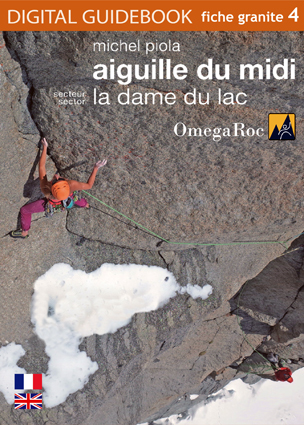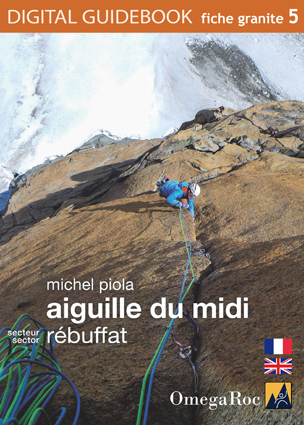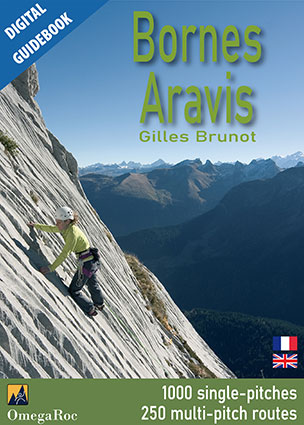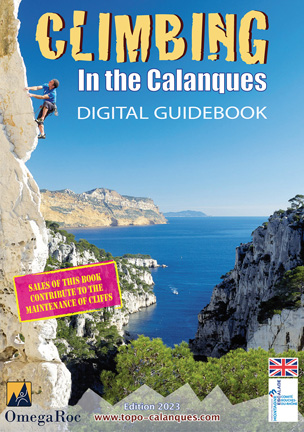Climbing guidebook at Aiguille du Midi

Rock climbing in the Mont Blanc massif
The Michel Piola’s “Fiches Granite’’
Michel Piola needs no introduction, as he is one of the most prolific route setters and re-bolters in the Mont Blanc massif. He is also the author of guidebooks for the Envers des Aiguilles and the Aiguilles Rouges.
His climbing guidebooks are now considered reference works, praised for their precision.
In his FICHES GRANITE (large folded sheets), Michel Piola focuses on a few particularly interesting walls for climbers and further enhances the level of information with extremely detailed diagrams, listing the in-situ gear and the gear to bring for each route.
The diagrams are particularly valuable for these rock faces where numerous routes intersect. Michel has a profound knowledge of these iconic walls, having climbed each of their routes (and opened several of them). He has also returned multiple times to rebolt (sometimes partially) most of them.
To learn more about the “Fiches Granite”, there’s no one better to explain than the author himself. Watch the short film next to this text (in French).
Today, several “Fiches Granite” are available in digital version on the OmegaRoc webapp. Find them below.
Les Gaillands – Chamonix
At the gates of Chamonix, in a picturesque setting facing Mont-Blanc, the Gaillands cliff is renowned for its numerous and well-equipped easy routes, perfect for beginners in climbing.
There are also routes for more experienced climbers with the steeper sectors of Chasseurs and Dièdre Frendo offering many routes between grade 6a and 7a.
The guidebook allows seamless navigation through more than 130 existing routes, thanks to the highly detailed photos and diagrams by Michel Piola.
The Gaillands – Trad Version / climbing
The rock at Gaillands is compact gneiss, splitted with numerous cracks. This feature makes it a unique place for learning and training climbing in trad style. The guidebook lists all the routes which are possible for trad climbing (over 70), indicating the necessary equipment, and even the bolts to clip for safe climbing.
For climbers, the South Face of the Aiguille du Midi is, along with the Grand Capucin and Les Drus, the most renowned wall in the Mont Blanc massif. The Rébuffat-Baquet route is the immense classic of the face, but numerous other more recent and often more demanding routes provide the opportunity to come and climb at the Aiguille again and again.
In total, around twenty routes have been established on this exceptional granite. You will find these routes in the two ‘’Fiches Granite” dedicated to Aiguille du Midi.
Le pilier Rouge de Blaitière
With its numerous classic routes, the Pilier Rouge de Blaitière is one of the jewels of the Aiguilles de Chamonix!
Close to the valley, it offers spectacular routes that can be climbed in a day on a steep pillar of perfect granite. The re-equipping of many of the routes, often with stainless glue-in bolts, has restored this rock face to its deserved glory.
The climbing is distinctly crack-oriented along very pure lines, but don’t forget your footwork as there are always some slabs to overcome.
Aiguille de Blaitière – Pointe Joséphine
On the Aiguille de Blaitière, Pointe Joséphine is the logical continuation of the routes on the Pilier rouge. Only three routes are described, but when combined with one of the routes on the lower part, they provide an incredible extension to your climb.
Except for the belays, these routes are either minimally equipped or not equipped at all and are reserved for fast climbers. Otherwise, you risk having to walk back down to the valley or spending an unplanned night out, as the last cable car will not wait for you.
Please note, this “Fiche granite” only describes the section above the Pilier Rouge. Access is only possible via one of the routes from Fiche granite N°1 and N°2.
La Chandelle du Tacul
The Chandelle du Tacul (3613m) is one of the satellite towers of the Grand Capucin. Despite its modest height, this exceptional granite needle, with its magnificent profile, is one of the most beautiful spires in the massif.
With a relatively quick glacier approach (1.5 hours), superb climbing, and an efficient abseil descent, the Chandelle du Tacul is a perfect objective for a stress-free day.
On excellent golden granite, four routes ascend exceptional crack lines with views of the glacier faces of Mont Maudit and Brenva on one side, and the nearby granite walls of the Trident and Grand Capucin on the other.
While all the routes are recommended, the Bonatti – Tabou combination is the great classic, offering a logical and consistent line at grade 6a-6b.
Climbing on the South Face of Aiguille du Midi
The South Face of Aiguille du Midi is a magnificent mineral face that offers, over a little more than 200m, all aspects of climbing on granite: perfect cracks, flawless dihedrals, slabs for balance, and a few overhangs. In short, it’s a type of climbing where technique and physicality often complement each other. You can always climb a beautiful hand crack using a laidback technique, but it is much more tiring (especially at 3600m) and challenging to protect.
Regarding the equipment, the crack lines are generally not bolted and need trad protection. You may find a few pitons, and rarely a “safety” bolt. The slab sections are equipped with bolts, with varying spacing depending on the preferences of the route setter.
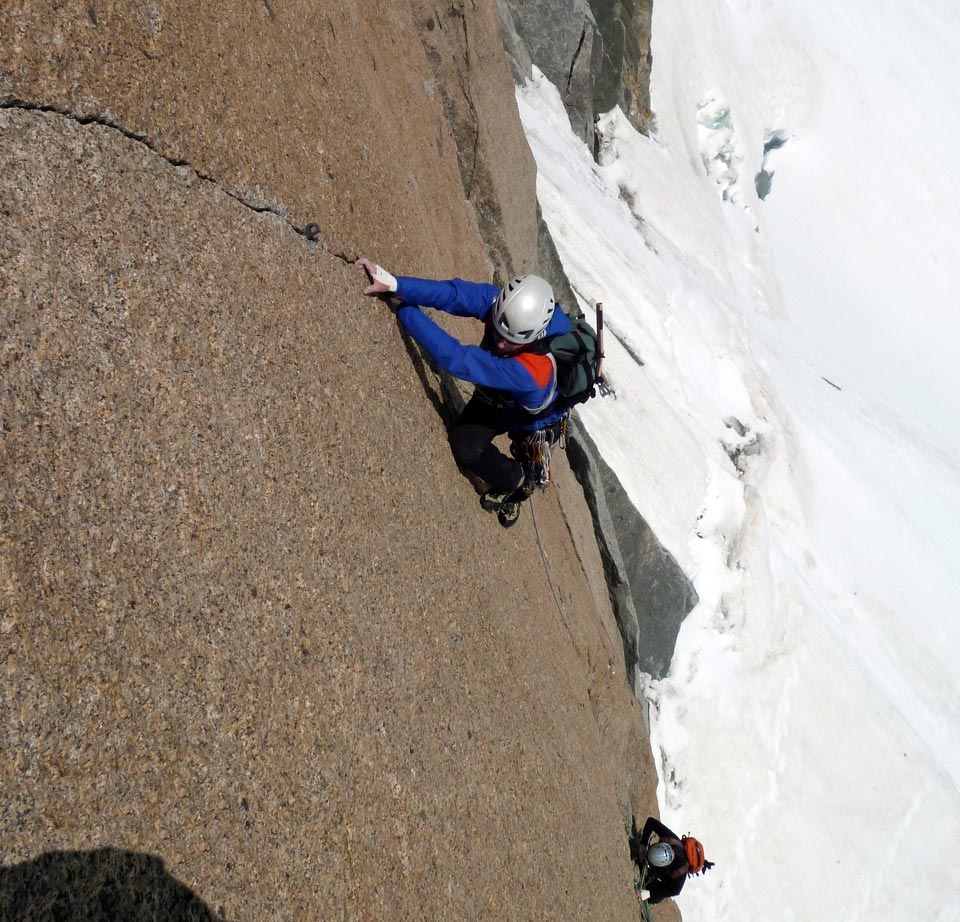
The twenty or so routes that intersect on the South Face offer numerous possible combinations, some of which have become great classics:
The Mazeaud/Rébuffat/Desmaison route for a technical and physical climb.
The Directe des trois dièdres combines the dihedrals of the Mazeaud, Ma Dalton, and Desmaison r A thematic climb!
In terms of strategy, there are three approaches, each with its pros and cons:
– Most parties reach the foot of the rock face via the East Ridge and, arriving at the summit, reach the Rébuffat terrace and the infrastructure of the Aiguille with a 30m rappel. In this case, you need to climb with all the necessary glacier equipment for the approach. It is often the second climber who will suffer from the extra load.
– Another option is to prioritize climbing light by leaving at the foot of the route your mountaineering boots and crampons and rappelling down from the top. In this case, you need to ascend to the Aiguille via the East ridge. And in that direction, it takes more than 20 minutes…
– Finally, it is possible to approach by rappelling from thle summit, which can be reached in one pitch from the Rébuffat Terrace. However, in case of abandoning the route, it is essential to have the necessary glacier equipment to go back to the cable car via the ridge.
In short, three methods, three philosophies!
This beautiful rock full of promises is located just an hour away from the heart of Chamonix. Only thirty minutes by cable car to cover 2800 meters of elevation and reach the Aiguille, five minutes of slaloming through tourists to reach the East Ridge, and twenty minutes using crampons to descend to the foot of the wall. The panorama is breath-taking. You climb above the immense glacial plateau of the Vallée Blanche, bordered from east to west by La Verte, Les Grandes Jorasses, La Dent du Géant, La Tour Ronde, the seracs of Tacul, and overlooking “its troops”, the mighty Mont Blanc itself.
Attention: High mountain terrain
The contrast is striking when you arrive from the tunnel that leads to the East Ridge. Just thirty seconds ago, you were strolling in the “photographer’s lounge,” and suddenly you find yourself on the top of a sharp ridge, steep on the right and even steeper on the left. Crampons and roping up are essential!
A 20-minute descent where it’s better to focus on your feet rather than the landscape, and then you lay your hand on the most beautiful rock in the world…
Granite of your dreams, warm sun, a quick approach, and a few climbing parties in the vicinity (it’s rare to climb alone at the Aiguille) quickly make you forget that you are in the high mountains. The first challenging sections will quickly remind you that something is missing in the air you breathe. And if the shadow catches up to you, I hope you haven’t forgotten your down jacket.
The weather can also suddenly change, and temperatures can suddenly drop significantly. It is essential to check the forecast for the day.
Climbing at Aiguille du Midi is a pleasure for vigilant and experienced climbers.
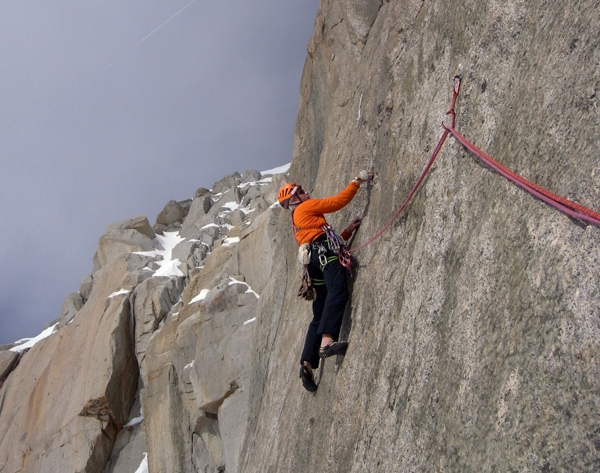
It happened at Aiguille du Midi…
Two days at the Aiguille du Midi: The Lachenal route (Pte Lachenal) and the Contamine at Aiguille du Midi
Alex Chabot free climbs the famous roof of Ma Dalton Route. Fortunately it’s also possible to aid climb it!
The Rebuffat-Baquet route climbed by the authors!
Clip from the film Entre Terre et ciel (in French only).
The combination Midi sonne/Sortie Desmaison.
Crack climbing in all its diversity
Explore the crags a little bit further… but not too far.
Here are some digital guidebooks for climbing in the surroundings areas.
To see all the guidebooks available on the OmegaRoc app: The OmegaRoc guidebooks


